Plyometric workout programs are designed to enhance muscular power and functional abilities through explosive movements․ These structured plans improve speed, strength, and agility, suitable for all fitness levels․
1․1 What is Plyometric Training?
Plyometric training, also known as jump training, involves explosive movements that rapidly stretch and contract muscles․ It uses short bursts of maximum force to improve power, speed, and reactivity․ Examples include jump squats, box jumps, and burpees․ This type of training enhances neuromuscular coordination and is widely used by athletes to boost performance and by fitness enthusiasts to improve overall physical conditioning․
1․2 Benefits of Plyometric Workouts
Plyometric workouts boost power, speed, and agility while enhancing muscle endurance and cardiovascular fitness․ They improve coordination and reactivity, making them ideal for athletes and general fitness enthusiasts․ Regular plyometric training can also aid in weight loss, as it burns calories efficiently․ Additionally, it strengthens muscles and joints, reducing injury risk and improving overall physical performance․ Consistency in plyometric exercises yields noticeable gains in strength and athletic ability over time․
1․3 Importance of Structured Programs
Structured plyometric programs ensure safety, progression, and optimal results․ They prevent overtraining and injuries by balancing intensity and recovery․ A well-designed program tailors exercises to fitness levels, enhancing explosive power and functional strength․ Proper structure also integrates plyometrics with other training methods, promoting holistic development․ This organized approach maximizes efficiency, helping athletes and individuals achieve specific goals effectively while minimizing risks․
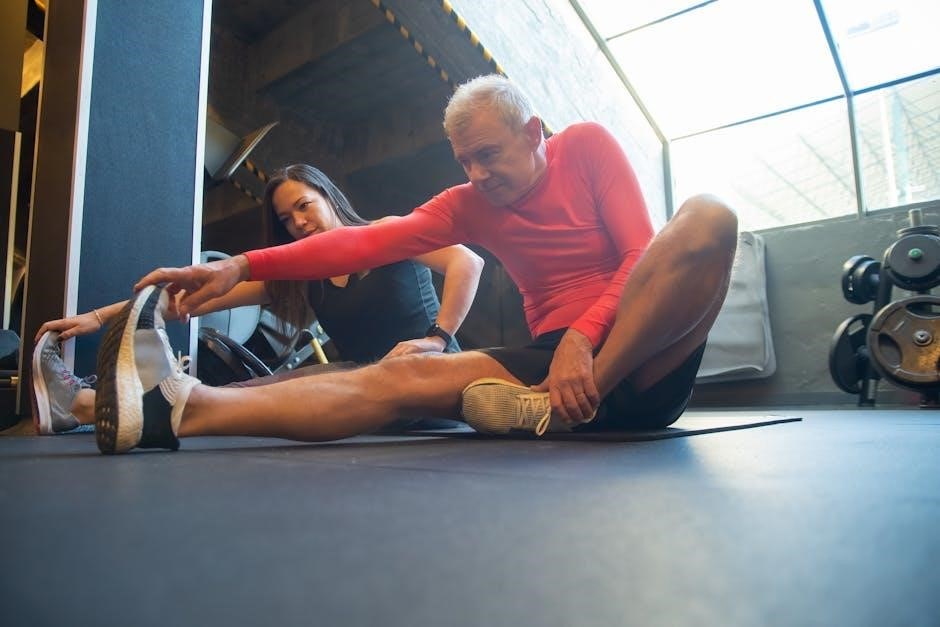
Understanding Plyometric Exercises
Plyometric exercises involve explosive movements, such as jump squats and box jumps, designed to enhance power, speed, and agility through dynamic muscle engagement․
2․1 Definition and Mechanism
Plyometric exercises, also known as “jump training,” involve rapid, high-intensity movements that enhance muscular power․ The mechanism relies on the stretch-shortening cycle, where muscles store energy during an eccentric contraction and release it explosively during a concentric contraction․ This process maximizes force production, improving speed, agility, and overall athletic performance․ Plyometrics target specific muscle groups, engaging them dynamically to build explosive strength and endurance․
2․2 Types of Plyometric Movements
Plyometric movements are categorized into lower body, upper body, and core exercises․ Lower body movements, like jump squats and box jumps, enhance power and speed․ Upper body exercises, such as medicine ball throws, improve throwing and pushing abilities․ Core-focused plyometrics, like clapping push-ups, boost stability and coordination․ Each type targets specific muscle groups, ensuring a well-rounded improvement in explosive strength and functional performance․
2․3 Key Muscle Groups Targeted
Plyometric exercises primarily target the lower body, including the quadriceps, hamstrings, glutes, and calves, which are essential for explosive power․ Upper body movements engage the chest, shoulders, and triceps, enhancing pushing and throwing abilities․ Core muscles, such as the abdominals and obliques, are also activated to improve stability and coordination․ This holistic engagement ensures comprehensive strength and functional performance across all major muscle groups․

Best Plyometric Exercises for a Full-Body Workout
Plyometric exercises deliver a full-body workout, enhancing power, agility, and calorie burn through dynamic movements that engage both lower and upper body muscles effectively․
3․1 Lower Body Exercises
Plyometric lower body exercises, such as squat jumps and skaters, target the quads, glutes, and hamstrings․ These movements enhance power, agility, and coordination while improving vertical jump and speed․ Lateral jumps and box jumps are also effective for building calf strength and explosiveness․ Incorporating these exercises into your routine boosts athletic performance and functional movement, making them essential for a well-rounded plyometric program․
3․2 Upper Body Exercises
Plyometric upper body exercises, such as clapping push-ups and medicine ball chest presses, enhance chest, shoulder, and core strength․ These explosive movements improve power and endurance while engaging multiple muscle groups․ Incorporating burpees and plyo push-ups into your routine boosts overall upper body athleticism and functional performance, making them essential for a comprehensive plyometric workout program․
3․3 Core and Functional Exercises
Core and functional plyometric exercises, such as plank jumps and rotational medicine ball throws, target the abdominals, obliques, and lower back․ These movements enhance stability, coordination, and explosive power․ Incorporating dynamic core exercises improves overall athleticism and functional strength, making them essential for a well-rounded plyometric workout program․

Designing a Plyometric Workout Program
Designing a plyometric workout program involves structuring exercises to suit fitness levels, ensuring progression, and balancing intensity with recovery for optimal performance and injury prevention․
4․1 Warm-Up and Preparation
A proper warm-up is essential before starting plyometric exercises․ It includes dynamic stretching, light cardio, and muscle activation to prepare the body for explosive movements․ Begin with 5-10 minutes of jogging, jumping jacks, or cycling to increase heart rate and blood flow․ Follow with dynamic stretches like leg swings, arm circles, and torso twists․ Incorporate plyometric-specific activations, such as small hops or heel raises, to engage key muscle groups․ Proper preparation ensures optimal performance and reduces injury risk․
4․2 Structuring the Workout
A well-structured plyometric workout balances intensity and recovery․ Start with foundational exercises like squat jumps or skaters, progressing to more explosive movements such as burpees or box jumps․ Include 3-5 exercises per session, focusing on lower and upper body․ Aim for 3-4 sets of 8-12 reps for each exercise․ Begin with lower intensity and gradually increase as the session progresses․ Allow 1-2 minutes of rest between sets for optimal performance and safety․
4․3 Cool-Down and Recovery
A proper cool-down after plyometric training is essential for reducing muscle tension and preventing soreness․ Incorporate static stretches for 20-30 seconds per muscle group, focusing on legs, hips, and lower back․ Gentle cardio, such as jogging or cycling, for 5-10 minutes helps lower heart rate gradually․ Foam rolling and hydration are also crucial for recovery․ Aim to cool down for 10-15 minutes post-workout to enhance flexibility and prepare muscles for future sessions․
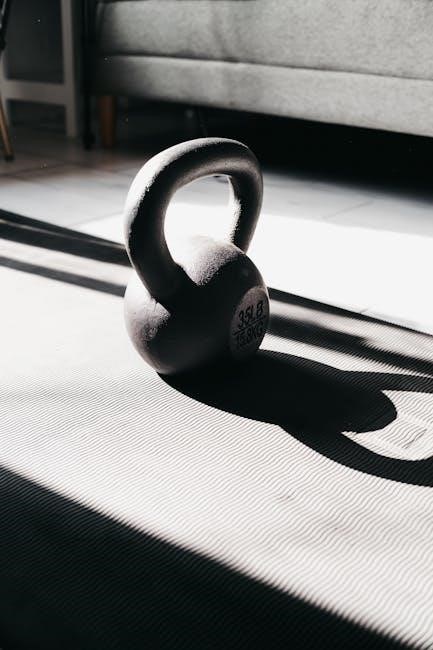
Plyometrics for Different Fitness Levels
Plyometric exercises are adaptable to various fitness levels, offering modified jumps for beginners and advanced drills like box jumps for experienced athletes, ensuring progression and safety․
5․1 Beginner-Friendly Plyometric Exercises
Beginners can start with low-impact plyometric exercises like bodyweight squat jumps, skaters, and step-downs․ These movements focus on building foundational power and coordination without excessive strain․ Squat jumps improve agility and balance, while skaters enhance lateral movement and leg strength․ Modifying exercises, such as reducing jump height or using assistive steps, allows individuals to progress safely․ Incorporating these drills 2-3 times weekly helps build confidence and strength gradually․
5․2 Advanced Plyometric Drills
Advanced plyometric drills include high-intensity exercises like burpees, box jumps, clapping push-ups, and weighted lateral jumps․ These movements require explosiveness and precision, targeting upper and lower body power․ Burpees combine strength and cardio, while box jumps enhance vertical leap․ Clapping push-ups improve upper body explosiveness, and weighted jumps add resistance for increased intensity․ These drills are ideal for experienced individuals looking to push their limits and refine athletic performance․
5․3 Modifications for Injury Rehabilitation
Modifications for injury rehabilitation focus on low-impact plyometric exercises to promote recovery while maintaining strength․ Techniques like step-ups, half-squats, and controlled jumps reduce stress on injured areas․ These exercises improve joint stability and muscle activation without high-risk movements․ Progression is gradual, ensuring proper healing and strength restoration․
Trainers often incorporate bodyweight movements and balance exercises to enhance functional mobility․ Monitoring progress and technique is crucial to prevent further injury and ensure safe rehabilitation․
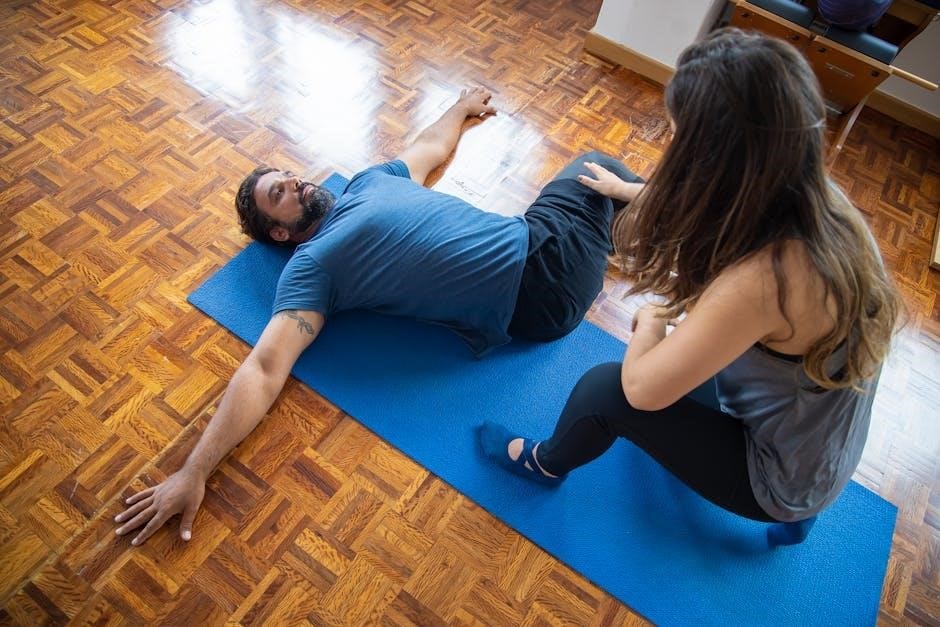
Safety and Injury Prevention
Plyometric exercises can be modified for injury rehabilitation by focusing on low-impact movements, such as step-ups and controlled jumps, to reduce stress on injured areas while promoting strength and stability․
Progression is gradual, ensuring proper healing․ Techniques like half-squats and balance exercises enhance joint stability without overexertion, making them ideal for rehabilitation programs under professional guidance․
6․1 Common Injuries in Plyometric Training
Plyometric training can lead to injuries such as ACL tears, shin splints, and hamstring strains due to repetitive jumping and explosive movements․ Overuse and poor form often contribute to these issues, particularly in the knees and lower extremities․ Proper warm-up, technique, and gradual progression are essential to minimize injury risks and ensure safe participation in plyometric exercises․
6․2 Proper Form and Technique
Proper form and technique are crucial in plyometric training to maximize performance and prevent injuries․ Maintaining a neutral spine, tracking knees over toes, and exploding upward with force are key․ Landing softly with knees bent reduces impact stress․ Engaging the core and keeping the chest upright promotes stability․ Focusing on controlled movements ensures efficiency and safety, making technique the foundation of effective plyometric exercises․
6․3 Precautions and Safety Tips
When performing plyometric exercises, prioritize proper footwear and a safe, open space․ Start with lower intensities and gradually increase to avoid overexertion․ Warm up thoroughly and cool down afterward to prevent muscle strain․ Avoid plyometrics if fatigued or injured, as this increases injury risk․ Focus on controlled movements and proper landing techniques to reduce stress on joints and muscles, ensuring a safe and effective workout experience․

Plyometrics for Athletes
Plyometrics enhance explosive power, speed, and strength, making them ideal for athletes․ These exercises improve sport-specific skills, boost performance, and combine well with weight training for peak athletic results․
7․1 Sport-Specific Applications
Plyometric training is tailored to enhance performance in specific sports, such as football, basketball, and boxing․ For example, box jumps improve vertical leap for basketball, while burpees boost endurance for swimmers․ These exercises target muscles used in explosive movements, like sprinting or jumping, ensuring sport-specific gains․ By incorporating sport-tailored plyos, athletes achieve faster results, improving power, speed, and agility critical to their discipline, leading to peak performance in competitive environments․
7․2 Enhancing Explosive Power
Plyometric exercises are ideal for enhancing explosive power by targeting fast-twitch muscle fibers․ Squat jumps, box jumps, and burpees are key movements that improve power output․ These exercises focus on rapid, dynamic movements that maximize force production․ Incorporating plyos 3-4 times weekly can significantly boost vertical jump height and sprint speed․ Proper form and progression ensure safe and effective gains in explosive capability, making them essential for athletes seeking peak performance․
7․3 Integrating Plyometrics into Athletic Training
Plyometrics seamlessly integrate into athletic training by enhancing explosive power and functional strength․ Coaches often combine plyos with weight training and cardio to maximize performance․ Structured programs ensure progressive overload, preventing plateaus and overtraining․ By tailoring plyometric drills to sport-specific demands, athletes achieve improved speed, agility, and endurance․ Proper periodization and recovery strategies are crucial to optimize results and reduce injury risks, making plyometrics a cornerstone of modern athletic development․
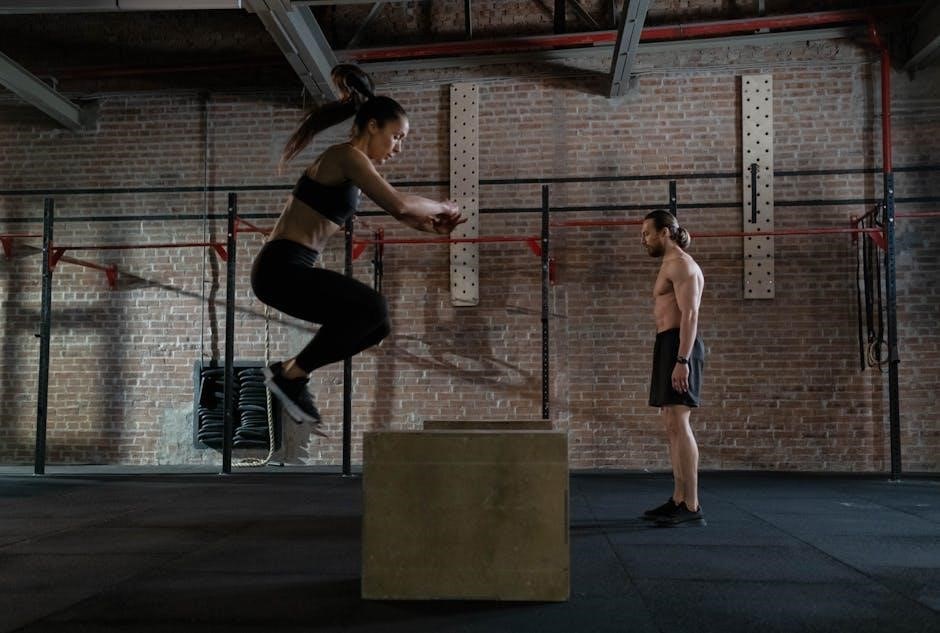
Combining Plyometrics with Other Training Methods
Combining plyometrics with strength training and cardio enhances power, speed, and endurance․ This integrated approach maximizes athletic performance and supports overall fitness goals effectively․
8․1 Plyometrics and Weight Training
Plyometrics and weight training complement each other by enhancing muscular power and explosiveness․ This combination improves strength, speed, and jump performance․ Performing plyometrics before weight training can boost power output, while weight training increases muscle mass and stability․ Both can be done on the same day or split into separate sessions for optimal results, leading to enhanced athletic performance and overall fitness․ This integrated approach maximizes benefits for strength and power․
8․2 Plyometrics and Cardiovascular Exercises
Plyometric exercises paired with cardiovascular workouts create a dynamic fitness routine that enhances heart health and endurance․ The high-intensity movements elevate heart rate, boosting cardiovascular benefits while improving muscular power․ This combination offers an efficient way to achieve overall fitness by incorporating plyometric drills into cardio sessions, resulting in better endurance and a balanced physique without requiring excessive time or equipment․
8․3 Plyometrics and Flexibility Training
Integrating plyometric exercises with flexibility training enhances overall mobility and prevents injuries․ Plyometric movements, such as jumps and hops, improve power, while flexibility routines increase range of motion․ Combining these elements balances explosive training with injury prevention, optimizing performance․ Incorporating stretches after plyometric workouts, when muscles are warm, maximizes flexibility gains and supports long-term athletic development without compromising strength or power․

Progression and Periodization
Plyometric workout programs should include structured progression and periodization to optimize performance․ Gradually increasing intensity ensures continuous improvement while minimizing injury risks, enhancing adaptability and results over time․
9․1 Gradually Increasing Intensity
Gradually increasing intensity in plyometric workouts is crucial for enhancing power, speed, and endurance; By progressively adding height, distance, or resistance, athletes avoid plateaus and prevent overtraining․ This method ensures consistent improvement while maintaining safety and efficiency, allowing the body to adapt naturally to higher demands over time․ Proper progression is key to achieving long-term success in any plyometric training program․
9․2 Periodizing Plyometric Workouts
Periodizing plyometric workouts involves organizing training into specific phases to optimize performance and prevent overtraining․ This approach alternates periods of high-intensity workouts with recovery phases, ensuring progressive overload․ By varying intensity, volume, and frequency, athletes can peak for competitions or specific goals․ Proper periodization balances explosive training with adequate rest, enhancing long-term progress and reducing injury risks․ It’s a cornerstone of effective plyometric program design for sustained improvement․
9․3 Monitoring Progress and Adjustments
Monitoring progress in plyometric training involves tracking metrics like jump height, power output, and exercise consistency․ Regular assessments help identify improvements or plateaus, allowing for timely adjustments․ Coaches and athletes should adjust training variables such as volume, intensity, or recovery periods based on performance data․ Incorporating deload weeks and modifying exercises ensures continued progress and prevents overtraining․ Adjustments should be data-driven to optimize results and maintain long-term effectiveness․
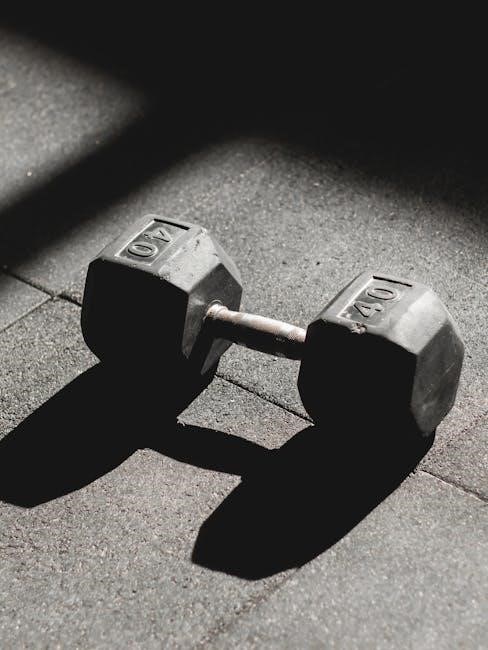
Frequently Asked Questions
Plyometric workouts are effective for improving power and speed․ Start with basic exercises, progress gradually, and ensure proper form to avoid injuries and maximize results․
10․1 Getting Started with Plyometrics
Begin with basic plyometric exercises like squat jumps and box jumps․ Focus on proper form and technique to prevent injuries․ Start with lower intensity and gradually increase as you build strength and confidence․ Warm-up with dynamic stretches and ensure adequate rest between sessions․ Consistency is key to seeing improvements in power and agility․ Avoid overexertion and listen to your body to maximize results safely․
10․2 Balancing Plyometrics with Other Workouts
Combine plyometric exercises with strength training and cardio for a well-rounded fitness routine․ Alternate plyometric days with weightlifting or endurance workouts to avoid overtraining․ Ensure adequate recovery time between sessions, as plyometrics are high-intensity․ Incorporate flexibility exercises to maintain mobility and prevent injuries․ Balancing plyometrics with other workouts enhances overall fitness without causing burnout or overexertion, ensuring sustained progress and injury prevention․
10․3 Overcoming Plateaus in Plyometric Training
To overcome plateaus in plyometric training, vary exercises, increase intensity, or adjust training volume; Incorporate periodized programs to avoid stagnation․ Focus on proper form to maximize efficiency and prevent injury․ Ensure adequate rest and recovery to allow muscle adaptation․ Integrate strength and flexibility training to enhance performance․ Seeking guidance from a professional can also provide fresh perspectives and tailored strategies to break through plateaus effectively․
Plyometric workouts are highly effective for improving power, speed, and overall fitness․ Consistency and proper form are key to achieving lasting results and enhancing physical performance․
11․1 Summary of Key Points
Plyometric workouts are highly effective for enhancing power, speed, and agility․ They engage multiple muscle groups, improving overall fitness and athletic performance․ Structured programs ensure progression, catering to all fitness levels․ Consistency and proper form are crucial for maximizing benefits and preventing injuries․ Plyometric training is versatile, suitable for both athletes and general fitness enthusiasts, offering a dynamic way to boost strength and endurance․ Regular practice leads to noticeable improvements in physical capabilities and overall well-being․
11․2 Final Tips for Success
Consistency and proper form are key to maximizing plyometric benefits․ Start with lower intensity and gradually increase as fitness improves․ Tailor programs to individual goals and fitness levels․ Incorporate recovery techniques like stretching and hydration․ Monitor progress and adjust routines to avoid plateaus․ Combine plyometrics with other training methods for a well-rounded regimen․ Stay motivated, and celebrate small achievements to maintain long-term success in your plyometric journey․
